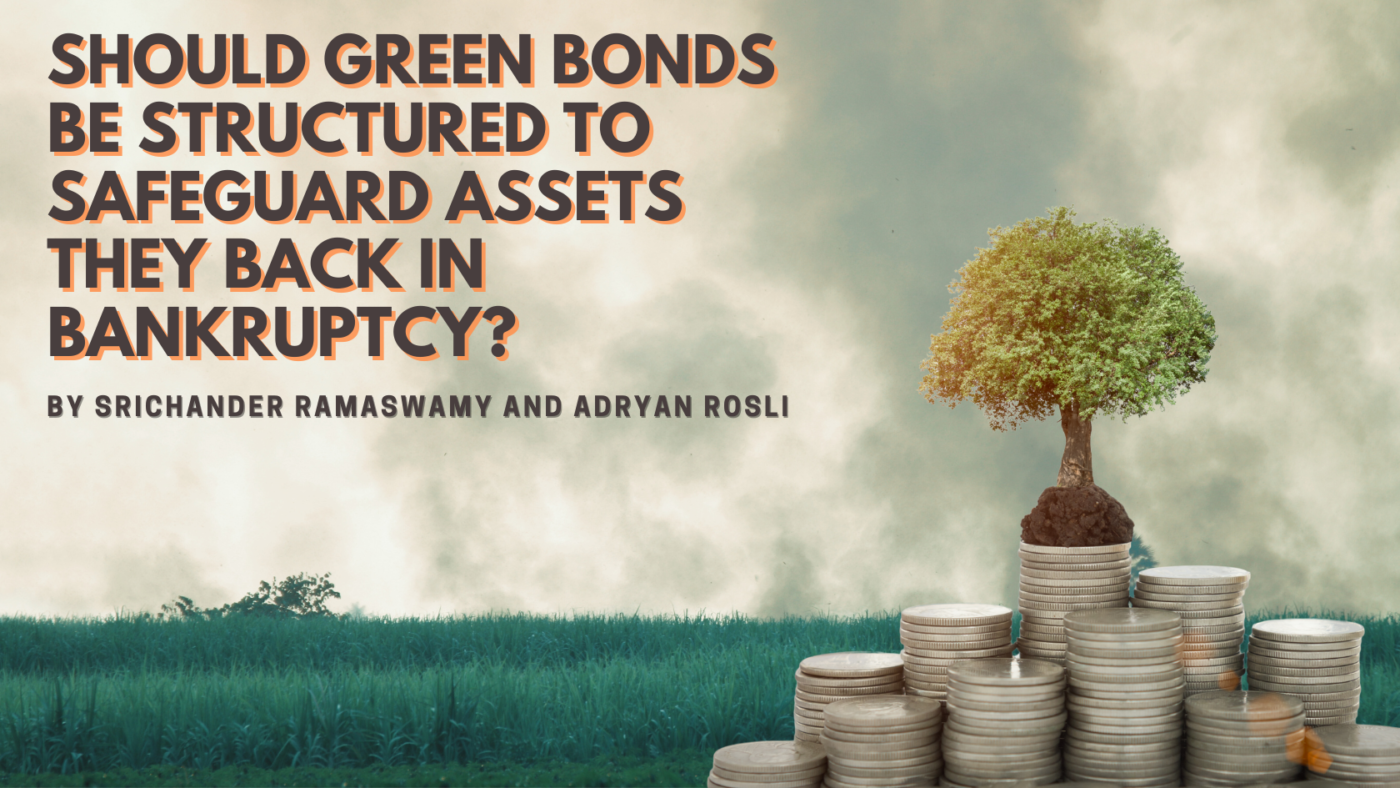Introduction
Every investment activity whether “brown” or “green” requires funding. Such funding is typically obtained through bank loans or by issuing securities in the capital markets. The interest and principal amounts borrowed are repaid using the cash flows generated by the investment activities. But when these cash flows are insufficient to meet repayment obligations on time, the company may file for bankruptcy. In such cases, the company’s assets are liquidated, and the proceeds are distributed to creditors according to the seniority of their claims. This hierarchy of claims is usually defined contractually at the time of issuance.
Until around 2015, investors primarily focused on a company’s business model and its ability to repay debt as it fell due. The nature of the activities being funded mattered less, so long as the business model was viable and sound. But the adoption of the 2015 Paris Agreement at the 21st session of the Conference of the Parties (COP21) to the United Nations Framework Convention on Climate Change (UNFCCC) marked a pivotal moment that catalysed a shift in mindset across the global investment community. Recognition that the severity and frequency of climate-related events had intensified over recent decades prompted a change in investor behaviour. Investors began to realise that prioritising climate-neutral investment activities — particularly in terms of greenhouse gas emissions — should be actively encouraged and supported.
As a result, many industries historically classified as “brown” have progressively shifted towards investing in “green” activities. This transition aims to reduce the risk of stranded assets, as regulatory pressures on brown investments increase and investor preferences continue to favour environmentally sustainable financing.
Funding investment activities that support the international agenda to reduce carbon emissions falls under the category of sustainable finance. Broadly, sustainable finance takes various forms — such as mitigation finance, adaptation finance and blended finance. Many brown companies seeking to lower their carbon footprint issue securities — such as green bonds or sustainability-linked bonds — to fund environmentally sustainable activities. The assets financed through these instruments are typically ring-fenced to ensure that the funds raised are used exclusively to finance green initiatives, and that the cash flows generated are directed towards servicing the associated debt obligations. That said, current practices around ring-fencing and Environmental, Social and Governance (ESG) reporting vary widely across jurisdictions.
As shown in Table 1, a range of companies — both private and state-owned — have tapped into sustainable finance to support their decarbonisation agendas. While green bonds are often ring-fenced, ensuring proceeds are dedicated to specific environmentally sustainable projects, this is not always the case with sustainability-linked bonds. For instance, Enel’s instruments are linked to key performance indicators (KPIs), rather than secured against specific cash-generating assets, and are therefore not ring-fenced. In contrast, firms like Repsol, ArcelorMittal and Indian Railways explicitly ring-fence proceeds to fund low-carbon infrastructure. The table also highlights that some companies, such as BP, employ hybrid funding approaches, using both internal and external sources, with only partial ring-fencing in place.
Table 1: Examples of Companies Issuing Sustainable Finance Instruments and Activities Funded
| Company | Instrument Used | Ringfenced | Green Activities Funded |
| BP | Sustainability-linked bonds + Internal funds | Partially | Clean tech, solar, hydrogen |
| TotalEnergies | Green bonds | Yes | Solar/wind investments |
| Enel | Sustainability-linked bonds | No | Renewables (linked to KPI) |
| Repsol | Green bond | Yes | Efficiency, low-carbon transport |
| ArcelorMittal | Green bond | Yes | Low-carbon steel, hydrogen |
| Indian Railways | Green bond | Yes | Electrification, sustainable transport |
This blog does not take a position on whether sustainable finance instruments genuinely fund environmentally beneficial activities or merely serve as a vehicle for greenwashing. Nor does it delve into accounting complexities — for instance, whether revenues generated from green assets are used specifically to service the debt attached to those assets, or are instead diverted to cover general-purpose liabilities of the parent company. Rather, as sustainable finance instruments continue to proliferate and attract significant capital allocation, this blog raises a more fundamental and underexplored question for institutional investors: how are these instruments and the assets they fund treated in the event of a default?
More specifically, the focus is on the treatment of securities categorised as sustainable finance when a brown parent company enters bankruptcy. In such cases, do the green-labelled bonds or the projects they fund receive any special treatment under existing bankruptcy laws, particularly when the contractual terms do not explicitly grant such privileges? To explore this, the blog examines the bankruptcy regimes of selected ASEAN economies to assess whether their legal frameworks provide any form of preferential treatment for green-financing instruments in the absence of explicit contractual provisions. It then raises a policy question with broader implications: is there merit in granting such preferential treatment through legal or regulatory channels? If so, what form of legal structure can better protect assets of green projects with minimal impact on the funding costs?
Taxonomy and Regulatory Support for Green Finance

ASEAN economies have embarked on an ambitious journey to support the financing of environmentally friendly and climate-neutral investment projects. This effort is underpinned by a strong push to develop the ASEAN Taxonomy for Sustainable Finance, which is designed to facilitate a just transition towards sustainable finance adoption across member states. The ASEAN Taxonomy is anchored in four Environmental Objectives (EOs): Climate Change Mitigation; Climate Change Adaptation; Protection of Healthy Ecosystems and Biodiversity; and Resource Resilience and the Transition to a Circular Economy. To be classified under the ASEAN Taxonomy, an activity must demonstrate a contribution to at least one of these EOs and must not cause significant harm to the others.
Within the ASEAN region, five countries — Malaysia, Singapore, Indonesia, Thailand and the Philippines — have made significant strides through regulatory frameworks and flagship green bond issuances. Malaysia, for instance, led the way with its pioneering green sukuk and a robust Sustainable and Responsible Investment (SRI) Sukuk Framework. The Securities Commission Malaysia (SC) oversees the issuance of green bonds and sukuk under this framework. Issuers are required to disclose the intended use of proceeds, and third-party reviews are commonly conducted to verify the “green” credentials. China has also created enabling regulation to help the country’s journey towards carbon neutrality and has built one of the largest green finance markets in the world.
Supported by these national regulatory frameworks and regional initiatives, green bond issuance has surged across the Asia-Pacific region in recent years. The region accounted for nearly USD 190 billion in green bonds in 2023 alone — second only to Europe. This momentum reflects growing government support, rising investor demand, and the mainstreaming of sustainable finance in emerging markets. But, while regulatory efforts have successfully promoted issuance, less attention has been paid to how investor claims on green projects will be treated in the event of default of the issuer who may also be financing brown activities.
This question becomes increasingly relevant as green- and transition-labelled bonds proliferate — often issued by companies with mixed environmental footprints (so-called “brown firms in transition”). A deep recession or adverse market event can impair a company’s cash flows, regardless of how green its investment plans may be. While taxonomies define what qualifies as a green investment, they do not determine how such instruments are treated under insolvency law.
In a typical corporate default, secured creditors are repaid first from pledged collateral. Preferential creditors (such as tax authorities and employees) are next in line. Unsecured creditors — including most green bondholders — are repaid only after these claims, while equity holders rank last. This means that unless the green bond carries secured or senior status, its holders are treated like any other unsecured creditor, despite the instrument’s environmental objective.
For example, in the United States (U.S.), green bonds are treated based on their legal structure — whether issued as general obligation or revenue bonds — and not based on their ESG label. Chapter 11 proceedings under the U.S. Bankruptcy Code make no distinction between green and non-green bonds. In Puerto Rico’s debt restructuring, ESG-labelled instruments were bundled with other unsecured bonds and received no special priority.
The next section will explore whether the bankruptcy regimes of the ASEAN-5 reflect any departure from this norm — or whether green bondholders in the region are likewise treated as general creditors in the absence of explicit legal or contractual safeguards.
A Look at the ASEAN-5’s Bankruptcy Regimes
Where preferential treatment is not grounded in the original contract, the legal treatment of green bond defaults remains aligned with traditional insolvency principles. Much like in the U.S., green bonds in the ASEAN-5 jurisdictions do not enjoy any statutory preference in the event of issuer default. But, unlike in the U.S. — where some ESG-labelled bond defaults have been tested in court — no such precedents have emerged in ASEAN-5. Below is a summary of the treatment of debt holder claims in the bankruptcy laws in each jurisdiction.
Malaysia
Malaysia’s corporate insolvency framework is governed by the Companies Act 2016 and the Insolvency Act 1967. Companies may pursue judicial management, court-sanctioned schemes of arrangement, or be wound up. Green bonds are not distinguished from other unsecured debt instruments under the law. Even where the use of proceeds is earmarked for green projects, Malaysian green bondholders do not enjoy preferential treatment unless specific security or seniority is contractually embedded.
Singapore
Singapore’s Insolvency, Restructuring and Dissolution Act (IRDA) 2018 provides a consolidated regime for corporate insolvency, including judicial management, schemes of arrangement, and liquidation. The IRDA makes no distinction between green-labelled and conventional debt. Green bonds fall under the general pool of unsecured creditors unless structured otherwise.
Indonesia
Indonesia’s insolvency regime, under Law No. 37 of 2004, features two primary mechanisms: PKPU (debt suspension for restructuring) and bankruptcy (liquidation). The system is creditor-friendly but contains no provisions recognising ESG-labelled or green financial instruments. Green bonds are treated as unsecured debt in both PKPU and bankruptcy proceedings.
Thailand
Thailand’s corporate rehabilitation framework is based on the Bankruptcy Act B.E. 2483 (1940) and its accompanying procedural law. There is no special category for green financial instruments. A case involving the renewable energy company Energy Absolute (EA) highlighted the practical treatment of green debt. Facing financial distress, EA restructured a 4 billion baht green bond maturing in September 2024 by extending its term and raising the coupon rate. The restructuring was negotiated under standard protocols; the green bondholders received no preferential treatment.
Philippines
The Philippines operates under the Financial Rehabilitation and Insolvency Act (FRIA) of 2010. This framework allows for either court-supervised rehabilitation or liquidation, depending on the debtor’s financial condition. FRIA does not distinguish between ESG-labelled and conventional debt. Green bonds are treated as general unsecured obligations unless contractually structured otherwise.
Key Takeaways
ASEAN-5 jurisdictions have made notable strides in developing sustainable finance taxonomies, disclosure frameworks and green bond markets. But in bankruptcy or restructuring proceedings, green and sustainability-linked bonds remain legally indistinguishable from conventional debt instruments. The lack of special treatment for green bonds under insolvency laws in the ASEAN-5 suggests that investor rights will depend on how these instruments are structured at issuance.
For purposes of illustration, TotalEnergies’ green bonds are issued not by its operational subsidiaries, but through dedicated financial vehicles under the parent company. Specifically, green bonds tied to TotalEnergies are issued by its financial subsidiaries (TotalEnergies Capital or Capital International), and are backed by guarantees from the parent company, TotalEnergies SE. ArcelorMittal Green Bonds are issued — and guaranteed — by the parent company, ArcelorMittal SA, rather than any specific operating subsidiary. Enel Finance International (EFI) raises funds, including green bonds, and lends them to the companies belonging to the Enel Group. Enel S.p.A. is the ultimate controlling shareholder of EFI, and all debt issued by EFI will have cross-default clauses forcing green bonds to default with others. In all these cases, there will be no preferential treatment of the bonds that fund the green investment under bankruptcy of the parent company. Recoverable amounts for creditors will depend on the contractual covenants of the green bonds.
How Should Green Bonds be Structured?
International efforts to foster the transition from brown to green investments is grounded in the belief that not only will this support the reduction in greenhouse gas emissions, but they will also reduce the risk of companies holding stranded assets. Yet, if the pace of green transition turns out to be slower than anticipated, many bond investors may still end up holding stranded assets. Under such a scenario, the recourse assets for repaying investors in brown bonds will be the assets of green investments of the company under the current structuring of green bonds. Such an outcome will be contradictory in nature to the global efforts to enable a just transition to climate-neutral environmental and sustainable investment activities.

Set against this backdrop, the existing bankruptcy regimes and forms of green bond issuances raise a number of policy questions. How should green bonds be structured? Should governments and regulators encourage green bonds to be structured such that they receive preferential treatment contractually in bankruptcy? How might such a structuring impact a brown conglomerate’s incentives to issue while show-casing their green credentials? While answers to these questions require deeper analysis, we provide some indicative answers to them.
Bankruptcy regimes are complex legal frameworks and have country-specific nuances. Tweaking them to accommodate green bonds to be given preferential treatment will create significant legal hurdles in implementation. Consequently, structuring green bonds at issuance to allow ring-fencing of the assets they fund — to be bankruptcy remote to the general creditors of the parent company — would be a better option. Embedding contractual seniority of green bonds in bankruptcy could also be an option that will boost investor confidence in such bonds, reduce financing costs for climate-neutral projects, and strengthen regulatory alignment with long-term sustainability goals. Formal recognition of green bonds as higher-priority claims could also correct for existing information asymmetries, where investors may mistakenly assume their claims on the green investments are protected or ring-fenced, only to be treated as ordinary unsecured creditors in a default. We explore below different ways to structure green bonds and highlight their pros and cons.
Contractual Seniority
Contractual seniority of bonds refers to the ranking of debt instruments based on the priority of repayment in the event of a borrower’s liquidation or bankruptcy. This hierarchy is determined by the terms outlined in the bond contract. Senior bonds hold the highest claim on the issuer’s assets and cash flows, ensuring they are repaid before subordinated or junior bondholders in bankruptcy. That said, the assets funded by the green bonds and structured to be contractually senior will still be used to repay other senior bondholders of the issuer if the green investments are not legally separated from the issuers’ other assets. While the green bondholders can expect higher recovery values on defaulted debt, the green investments will become part of the insolvency estate and subject to lengthy negotiation with no guarantees for continued operation.
Dual Recourse Bonds
Many of us will be familiar with covered bonds issued in European countries. These are debt securities issued by a bank or mortgage institution and collateralised by a pool of mortgage assets. At the same time, covered bonds continue to be obligations of the issuer and the investor has recourse against the issuer and the collateral, sometimes known as “dual recourse”. Covered bond regulations in most jurisdictions are designed specifically for banks and mortgage lenders and they must be backed by high-quality, standardised assets, typically residential mortgages. Covered bonds also receive favourable treatment in terms of capital requirements, making them attractive to regulated investors, which in turn lowers their funding costs.
A natural question to ask is whether green bonds may benefit from a similar structuring and dual recourse mechanism. The challenge is that non-financial corporates usually do not have such homogeneous, high-quality, long-term asset pools to serve as collateral. Moreover, the cost of setting up a covered bond program (legal, structural, rating-related) may outweigh the benefits for non-financial corporates. It is more common among corporates with receivables, leases, or even trade finance assets to package them into securitized notes. Unlike covered bonds, these assets move off balance sheet and are tailored to corporate-specific cash flows.
The green bond issuances cited earlier suggest that corporates have preference for issuing green-labelled bonds through their financing arm and then retain them on their balance sheet. Issuing green bonds through financial subsidiaries they control can lead to lower funding costs. If governments want to ensure that the green investment activities do not fold into the general bankruptcy estate of a brown conglomerate under such practices, the covered bond structure can be a useful construct. But to realise this, legal frameworks have to be adapted to enact special purpose covered bond laws that allow green investments to be ring fenced while allowing corporates to issue such bonds and hold them on their balance sheet.
Off-Balance Sheet Funding
Green projects can be funded directly by the subsidiaries that are set up by conglomerates and moved off-balance sheet. Investors who fund such projects can be certain that their proceeds will fund activities that support green transition, and the assets will not be used to pay investors in other asset classes. Alternatively, the green investment can be funded by creating a special purpose vehicle (SPV) that issues the green bonds, which isolates the pooled assets from the parent company’s balance sheet. Often, over-collateralisation or guarantees are employed to improve the credit quality of the securitisation.
The off-balance sheet funding structures for green investments are not common. There are several reasons for this. First, setting up the securitisation structure, getting parties to provide credit enhancements, getting a rating from credit agencies and paying investment banking fees for marketing the securities are all expensive. Second, securitisation structures are more common when the underlying assets are income generating. New projects that fund green investments may take time to generate revenue and therefore pose cashflow challenges. Third, there will be very little incentive for the brown conglomerate to take such projects off-balance sheet. When done, the conglomerate cannot claim the “green” credentials and meet their target ESG scores. Consequently, there will be no incentives for them to set up such off-balance sheet projects.
Conclusion
Public authorities and the regulatory community have so far focused on supporting markets for green finance and in preparing the taxonomy for green investments. Less attention has been paid so far to how these assets will be treated, and who will have recourse to them when a brown conglomerate issuing the green-labelled bonds enters bankruptcy. By examining the bankruptcy regimes across the ASEAN-5 suggests that green bonds do not receive any special treatment and the assets backing them will be part of the bankruptcy estate that will be shared with all creditor categories.
Existing issuance patterns of green bonds tends to suggest that large corporations issuing such bonds prefer to hold them on their balance sheet to market their green credentials and meet their targets on reducing greenhouse gas emissions. While this may offer funding advantages for early-stage investment projects, comingling these assets with assets backing brown projects in corporate restructurings or bankruptcy proceedings is a suboptimal outcome for environmentally friendly projects. One alternative would be to create enabling regulation to support covered bond laws that are specific to non-financial corporates. Another alternative would be to allow green bonds issued by conglomerates to be moved off-balance sheet when the investments they fund become mature. At the same time, the conglomerate should be allowed to continue to benefit from the ESG scores even if the subsidiary does not have to be consolidated in the financial accounts of the conglomerate. This will ensure that the green projects remain bankruptcy remote.

